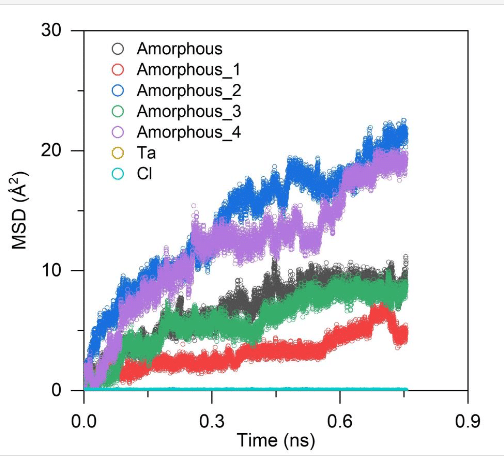These batteries can operate stably up to 9800 cycles with around 77% capacity retention at a high rate of 3.4C in a freezing environment of −10°C.
Researchers at University of Science and Technology of China (USTC) have introduced a new class of amorphous Li–Ta–Cl-based chloride solid electrolytes (SEs). These SEs demonstrate high lithium-ion conductivity (up to 7.16 mS cm-1 ) and a low Young’s modulus (approximately 3GPa). The high conductivity facilitates efficient lithium-ion transport, while the low Young’s modulus ensures good physical contact among the rigid components within ASSLBs, both critical factors for battery performance.
The research represents a significant advancement in the development of all-solid-state lithium batteries (ASSLBs), particularly in the context of SEs. SEs are crucial for the performance of ASSLBs due to their role in facilitating lithium-ion conduction. Amorphous solid electrolytes (ASEs) are especially promising for ASSLBs because they lack grain boundaries, which typically impede ion conduction. This grain-boundary-free structure promotes intact solid–solid contact and uniform lithium-ion conduction, essential for high-performance cathodes.
The existing amorphous oxide SEs suffer from limited ionic conductivities. Glassy Sulphide SEs are constrained by narrow electrochemical windows. As a result they have been unable to support high-nickel cathodes effectively. High-nickel cathodes are desirable in lithium batteries for their high energy density, but they also pose challenges in terms of stability and compatibility with SEs.

The research team used machine-learning simulation, solid-state 7Li nuclear magnetic resonance, and X-ray absorption analysis to characterise the structure of the amorphous Li–Ta–Cl matrix. They discovered that it comprises LiCl43–, LiCl54–, LiCl65– polyhedra, and TaCl6– octahedra. This unique composition contributes to the SEs’ high performance.
These amorphous chloride SEs exhibit excellent compatibility with high-nickel cathodes. The study demonstrates that ASSLBs equipped with these SEs and high-nickel single-crystal cathodes (specifically LiNi0.88Co0.07Mn0.05O2) show remarkable performance. They maintain approximately 99% capacity retention after 800 cycles at around 3C under 1 mA h cm–2 and about 80% capacity retention after 75 cycles at 0.2C, even with a high areal capacity of 5mA h cm–2. Most notably, these batteries can operate stably up to 9800 cycles with around 77% capacity retention at a high rate of 3.4C in a freezing environment of −10°C.
The introduction of amorphous chloride SEs is a major step towards high-performance, high-nickel cathodes for high-energy-density ASSLBs. This development has the potential to significantly enhance the efficiency, capacity, and durability of lithium batteries, paving the way for more advanced energy storage solutions.






